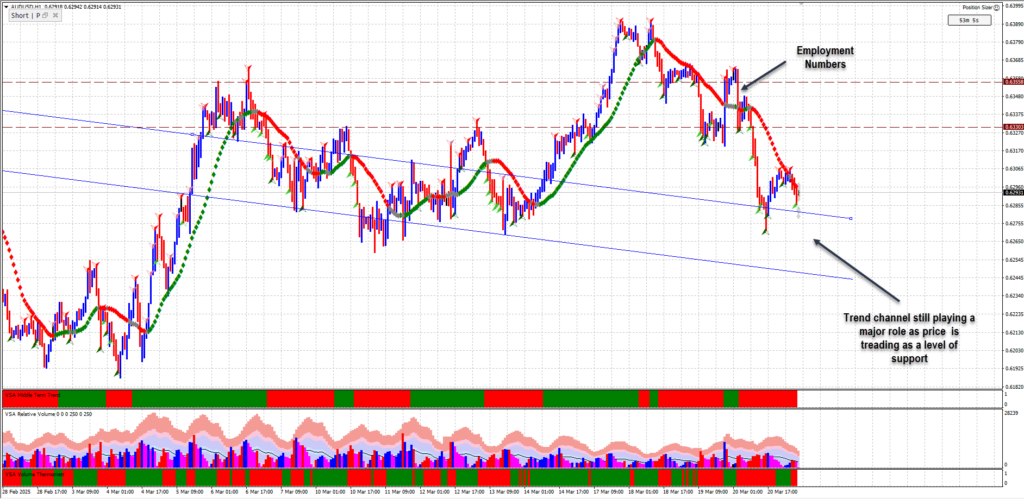Australia’s labour market took an unexpected hit in February 2025. The Australian employment data dropped sharply, surprising markets and analysts. The Australian Bureau of Statistics (ABS) released the data on March 20. It had an immediate impact on the Australian dollar. It also shifted expectations for the Reserve Bank of Australia’s (RBA) next move. This article breaks down the employment data for February 2025. It covers job losses and market response and explains what it means for the broader economy.
Australian Employment Data Breakdown (February 2025)
Australian employment data for February 2025 revealed a significant and unexpected downturn. Australia lost 52,800 jobs in February 2025. This figure is far below market expectations, which predicted a gain of around 30,000 jobs. It also reverses January’s upwardly revised increase of 30,500 positions. Most of the job losses were in full-time roles, raising concerns about softening labour demand.
Despite this, the unemployment rate held at 4.1%. A small drop in labour force participation helped offset the job losses. Yet, this could mask deeper problems if fewer people are actively looking for work.
Market Reactions to Australian Employment Data and AUD Impact
The Australian dollar dropped sharply after the data was released. The AUD/USD pair fell to 0.6280 during North American trading on March 20. This reflected a swift change in market sentiment and rate-cut expectations.
Traders raised the odds of an RBA rate cut at the May policy meeting. The chance of a cut rose from 70% to 78% in just hours. Currency markets are highly sensitive to labour data, especially when it signals a policy shift.
RBA Policy Outlook Following February 2025 Australian Employment Data
The RBA may now face more pressure to ease policy. Although the central bank has been cautious, weak employment data could push it to act sooner. Supporting consumer confidence and maintaining momentum may become a priority.
If upcoming data like inflation or retail sales also disappoint, a rate cut in May is likely. Some analysts suggest the RBA could revise its economic outlook if labour weakness continues.
Broader Economic Impacts of February 2025 Employment Data
These job losses raise questions about Australia’s economic recovery. Inflation remains elevated but is cooling. Interest rates have already started to pinch household budgets.
Sectors such as construction, retail, and manufacturing may feel the strain if hiring slows further. Policymakers will watch closely to see if February’s result is a one-off or the start of a deeper slowdown.
Conclusion: Key Takeaways from Australian Employment Data February 2025
The release of the Australian employment data for February 2025 is a major talking point. Economists are discussing it extensively. Market participants are closely analyzing the implications. Losing 52,800 jobs in February 2025 has sent a warning signal to markets. It has also increased pressure on the RBA to act. With the economy at a crossroads, the labour market will remain a key focus. The next few weeks could reveal whether this is a minor delay. Alternatively, it could be a sign of more trouble ahead.
What does this mean for the Australian Dollar?

On the 1-hour AUD/USD chart, we observe a classic Wyckoff reaction following a sharp markdown. Price drives downward aggressively, reaching the lower boundary of a well-defined trend channel—currently serving as support. At this level, two key VSA signals emerge. The first signal is a wide-spread down bar on high volume. It pierces the channel, likely representing climactic selling or supply absorption. Immediately afterward, we see a stopping volume bar, indicating that professional money may be stepping in to halt the decline.
The current candle shows a test back into the area of prior demand. It is on narrowing spread and lower volume. This is suggestive of a successful test. If no further supply emerges here, this could confirm the presence of institutional accumulation. Should this be validated by follow-through buying, a bullish move back toward the 0.63303 trigger zone becomes increasingly probable, aligning with Wyckoff’s Phase C or early Phase D in the accumulation schematic.
FAQs
What caused the job losses in February 2025?
The drop was mainly due to fewer full-time jobs. This hints at weaker demand in major industries.
Why did the Australian dollar fall after the employment data?
The weak jobs report increased expectations of RBA rate cuts. That made the AUD less attractive.
What is the current unemployment rate in Australia?
It stayed at 4.1% in February 2025, unchanged from January.
Will the RBA cut interest rates in May 2025?
Markets now expect a 78% chance of a rate cut in May. That’s up from 70% before the data release.
How does this affect Australia’s outlook?
Weak job data could slow the economy. If it continues, the RBA may change its policy to support growth.

Leave a Reply